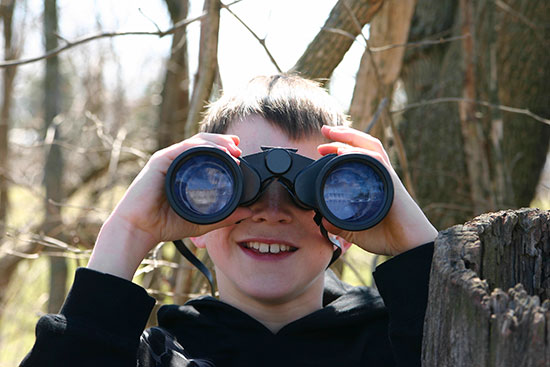Binoculars buying guide

If only our eyes were as keen as an eagle’s. Eagle eyes can see up to eight times better than the sharpest human eyes, and a golden eagle can even watch its prey from a mile away.
If you could see that well, what would you do?
Besides zooming in on birds and other wildlife, you could use your super vision to check out a campsite from a long way off, or see the stitches on a baseball as your favorite pitcher hurls it toward home plate.
With binoculars, all of that is within reach. But first you have to pick the right pair for the job. It’s easy if you know what to look for—and what to look out for. To make the shopping easier we hooked up with Jim Wilson, an award-winning birder (you might call him a Super Bird-Watcher).
Here are Wilson’s tips:
THE LOWDOWN
Binoculars are like a pair of telescopes strapped side-by-side. Here’s basically how they work: A pair of convex (or curved) lenses bring the image closer while a pair of prisms (like chunks of glass) flip the image so what shows up in front of your eyes is a true—and much zoomed in—version of what you’re looking at.
There are three sizes of binoculars: standard, compact and pocket. Standard binoculars provide the best magnification and clarity, though they can be bulky and heavy. Compact binoculars are smaller and more manageable while still providing relatively good performance. Pocket binoculars are small enough to fit into a pocket but won’t provide as much magnification and clarity.
PRICE
In general, the more you spend the better the optical quality. Sure, there are $1,000 binoculars, but you can still get a good pocket pair for around $50. About $300 will get you a pair of quality full-size binoculars that should be all you’ll need for many years.
SIZE MATTERS
When shopping for binoculars, you’ll see numbers like 7×32 and 8×42. The first number refers to the magnification, so a 7-power binocular gives you roughly seven times your normal eye’s power. The second number is the size of the lens in millimeters. The wider the lens, the more light that comes through, so the brighter the image appears. When it comes to magnification, more isn’t always better.
“The higher the magnification, the more shake you’ll get while handholding them,” Wilson says. “You’ll also have less of a wide field of view,” meaning you’ll zero in and see less of the overall scene. Look for binoculars in the 7 to 8 power range.
Anything over 10 will require a tripod to keep them steady.
GOOD GLASS
The difference between models in binoculars often comes down to lens coatings. “A lot of coatings give you higher contrast for a sharper image and more definition between colors,” Wilson says. If you can afford it, choose fully coated optics.
FIND YOUR FIT
“One of the most important things is how they feel,” Wilson says. “Does your finger sit comfortably on the focus wheel? Does the distance between your eyes match the eyepiece?” Also, if you’re a small guy, don’t pick a huge pair of binoculars that are so heavy they weigh you down. If they aren’t comfortable, you won’t want to use them.
SEEING IS BELIEVING
“Try before you buy,” Wilson says. Go to a store that sells lots of binoculars and try as many as you can. Focus on things way across the store and look out the window. Online stores are fine, but Wilson recommends making your final purchase at a local store. “You want to test out the exact pair you’ll be buying because optical quality can vary even between two pairs of the same binoculars.”
how can i get cheap and good pair dude.
Try the “Binolux 8×21 binoculars”.
I have camera binoculars
tascos binoculars are really good
buy a good pair of binoculars that are good and the one you like.
Did you try a pair of Night Vision Binoculars? My 4 year old enjoys them more than anybody in my family for deer watching.
i got the Bushnell PERMAFOCUS i love them
Thanks a lot, Jim Wilson!!! I’m a budding birdwatcher myself. I’ve seen 17 different types of birds and I’ve only been watching for 1 month!
Hey guys the reason you don’t need a telescope for the merit badge or star gazing is summed up in 3 words “Field of view”. Are you looking at the outer most reaches of our galaxy or the constellation of Ursa Minor? That’s the difference.
Binoculars instead of a telescope? Weird… =P
i know but it works ive tried it
when I was doing astronomy merit badge the guy said to geta good pair of binoculars in stead of a telascope